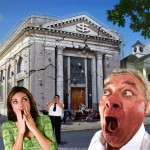At the peak of the financial crisis in October 2008, as Americans lost their homes because they were unable to service mortgages, foreign banks were the biggest borrowers from the U.S. Federal Reserve, accounting for 70 percent of all loans, just released documents under the Freedom of Information Act show.
 Dexia SA based in Brussels and Paris, borrowed as much as $33.5 billion through its New York branch from the Fed’s “discount window” lending program. Next, Dublin-based Depfa Bank Plc, which was eventually seized by the German government, borrowed $24.5 billion.
Dexia SA based in Brussels and Paris, borrowed as much as $33.5 billion through its New York branch from the Fed’s “discount window” lending program. Next, Dublin-based Depfa Bank Plc, which was eventually seized by the German government, borrowed $24.5 billion.
Wachovia Corp. was the only U.S. bank among the top five discount-window borrowers as the crisis peaked.
“The American people are going to be outraged when they understand what has been going on,” U.S. Representative Ron Paul, a Texas Republican who is chairman of the House subcommittee that oversees the Fed, said in a Bloomberg Television interview.
“What in the world are we doing thinking we can pass out tens of billions of dollars to banks that are overseas?” said Paul, who has advocated abolishing the Fed. “We have problems here at home with people not being able to pay their mortgages, and they’re losing their homes.”
In separate documentation, big foreign banks were also major borrowers from temporary emergency lending programs established by the Federal Reserve. Six European banks were among the top 11 companies with a combined borrowing of $274.1 billion. This program also loaned hundreds of billions to the biggest U.S. banks, including JP Morgan Chase, Bank of America, Citigroup Inc. and Morgan Stanley.


